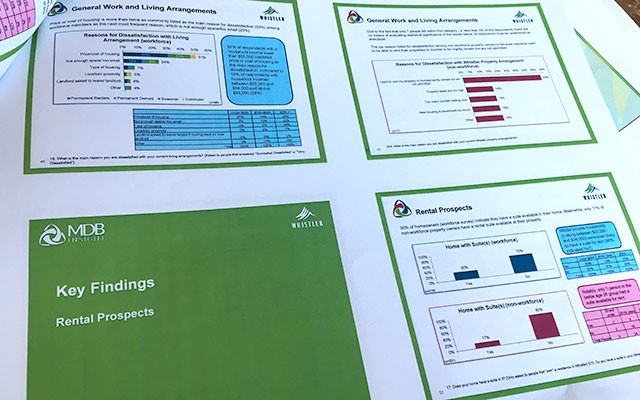A survey on Whistler's housing situation that garnered more than 2,000 responses has boiled down to three key themes moving forward: making better use of existing supply, increasing the inventory of homes and ensuring available homes are being used properly.
The survey — which was conducted through March and April — included 401 randomly contacted phone participants, 356 in-person interviews conducted at high-traffic locations in Whistler and 1,519 online respondents.
"In terms of next steps, the survey data will be used to specifically identify the type and the quantity of future needs," said Resort Municipality of Whistler (RMOW) economic developer Toni Metcalf in a media briefing ahead of the June 6 council meeting.
What those needs are right now isn't immediately clear.
"It is a lengthy process to understand all the data, but it's important that it will happen in parallel with the other initiatives that are already in play, and it will also inform those initiatives and where additional levers may need to be explored," Metcalf said.
Current initiatives already underway through the Mayor's Task Force on Resident Housing include the Home Run program, increased enforcement of illegal nightly rentals and four housing projects in various stages of development.
Work has also begun on a master plan for Cheakamus Crossing.
"It's very early, it's still in the preliminary stages, but really it's about exploring those lands that are owned by the RMOW in Cheakamus, evaluating the land suitability and the potential down there for additional employee housing," Metcalf said. "It will end up with a master plan essentially outlining opportunities there, but ensuring it integrates with the existing neighbourhood."
The task force was put on hold until the survey could be carried out, but the data will help inform council's decision-making moving forward, said Mayor Nancy Wilhelm-Morden at the council meeting June 6.
"We know that we are on the right track and we'll make better decisions as a result," she said. "It slowed the process down and took about three months more than what we thought it would, but I'm really glad we did it."
A community forum on housing is planned for the fall.
The survey responses were broken down into five "respondent profiles:" Permanent Resident Owners (who are part of the workforce), Permanent Resident Renters, Seasonal Residents, Commuters and Owners not working in Whistler.
According to the survey, 82 per cent of the workforce in the community reported being somewhat or very satisfied with their current living arrangements, though seasonal renters are unsurprisingly the least satisfied segment of that group, with less than 20 per cent of respondents saying they are very satisfied.
Thirty-four per cent of seasonal renters expressed some level of dissatisfaction with their current situation, as did 22 per cent of permanent renters.
The younger the respondent, the less likely they were to be satisfied, with those making less than $25,000 the least likely to be satisfied.
Workforce members were most dissatisfied with the cost of housing (53 per cent), followed by the space of their accommodation (25 per cent).
Only 30 per cent of workforce property owners reported having suites on their properties, and only 17 per cent of non-workforce owners. Of those respondents, 10 per cent of workforce owners and 24 per cent of non-workforce owners said they're not renting their suites.
Despite 71 per cent of non-workforce owners being aware they can rent their homes to businesses, more than 75 per cent of them said they were "not at all likely" to rent their homes to either seasonal or permanent workers.
In terms of future housing plans, 59 per cent of workforce respondents said they anticipate a change in living arrangements in the foreseeable future (27 per cent within the next one to three years, 21 per cent immediately and 19 per cent in the next three months).
Affordability (22 per cent), a need for more space (16 per cent) and current home no longer being available (11 per cent) are the main factors for those changes.
Head to www.piquenewsmagazine.com for more on this story.
The full survey results can be found at www.whistler.ca/services/housing/community-housing-survey.




